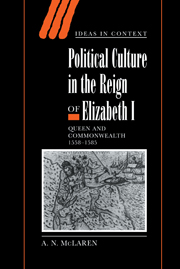Book contents
- Frontmatter
- Contents
- Acknowledgements
- Introduction
- 1 ‘To be Deborah’: the political implications of providentialism under a female ruler
- 2 Announcing the godly common weal: Knox, Aylmer and the parameters of counsel
- 3 Feats of incorporation: the ideological bases of the mixed monarchy
- 4 Contesting the social order: ‘resistance theory’ and the mixed monarchy
- 5 Godly men and nobles: the bicephalic body politic
- 6 Godly men and parliamentarians: the politics of counsel in the 1570s
- 7 Rewriting the common weal: Sir Thomas Smith and the De Republica Anglorum
- Afterword
- Bibliography
- Index
- IDEAS IN CONTEXT
5 - Godly men and nobles: the bicephalic body politic
Published online by Cambridge University Press: 06 August 2009
- Frontmatter
- Contents
- Acknowledgements
- Introduction
- 1 ‘To be Deborah’: the political implications of providentialism under a female ruler
- 2 Announcing the godly common weal: Knox, Aylmer and the parameters of counsel
- 3 Feats of incorporation: the ideological bases of the mixed monarchy
- 4 Contesting the social order: ‘resistance theory’ and the mixed monarchy
- 5 Godly men and nobles: the bicephalic body politic
- 6 Godly men and parliamentarians: the politics of counsel in the 1570s
- 7 Rewriting the common weal: Sir Thomas Smith and the De Republica Anglorum
- Afterword
- Bibliography
- Index
- IDEAS IN CONTEXT
Summary
The queen's majesty hath no surety but as she hath been counselled.
Lord Burghley to the Earl of Leicester, (1572)The ‘mixed monarchy’ enacted in Elizabeth's reign was rooted in a theoretical framework of revived Aristotelian and Polybian ideas of a mixed constitution, infused with theological terminology and metaphors, and newly prominent in the wake of the conciliar movement and the reformation. But it would have been inconceivable without the local habitation provided, in England, by the regnal sequence after Henry VIII of one short-lived minor king and three queens. In Elizabeth's reign, one anonymous writer explicitly recognised the unprecedented character of England's history since the Henrician Reformation. The author of The History of the Reign of King Henry the Eighth, king Edward the Sixth, Queen Mary, and part of the Reign of Queen Elizabeth, dateable on internal evidence to the late 1570s, justifies the interest of his work on the basis of the innovative enactments of kingship which have occurred since the advent of the Tudor dynasty:
Then if you shall restrain your consideration to the state of this monarchy; first there will occur unto you changes rare, and altogether unknown unto antiquity, in matters of religion, and the state ecclesiastical. Then to behold the several reigns of a king, that first, or next the first, became absolute in the sovereignty; of a king, in minority, of a queen, married to a foreigner; and lastly, of a queen that hath governed without the help, either of a marriage, or of any mighty man of her blood.
- Type
- Chapter
- Information
- Political Culture in the Reign of Elizabeth IQueen and Commonwealth 1558–1585, pp. 134 - 160Publisher: Cambridge University PressPrint publication year: 1999



